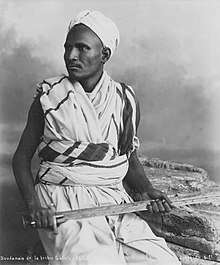Ja'alin tribe
| Ja'alin جعليون | |
|---|---|
 Warrior from the tribe of the Ja'alins | |
| Ethnicity | Sudanese Arab |
| Location | Nile river basin between Khartoum and Abu Hamad |
| Population | 3,299,000[1] |
| Language | Arabic, Sudanese Arabic[1] |
| Religion | Sunni Islam |
The Ja'alin, Ja'aliyin or Ja'al (Arabic: جعليون) are an arabized Nubian[2][3][4] tribe in Sudan, constituting a large portion of the Sudanese Arabs. They trace their origin to Ibrahim Ja'al, who was in turn a descendant of al-Abbas, an uncle of prophet Muhammad. The Ja'alin formerly occupied the country on both banks of the Nile from Khartoum to Abu Hamad.[5] Although speaking Sudanese Arabic today the tribe is recorded to have spoken some, now extinct, form of Nubian as late as the 19th century.[6]
History
The Ja'alin trace their lineage to Abbas, uncle of the Islamic prophet Muhammad.[5] At the Egyptian invasion in 1811 they were the most powerful of Arab tribes in the Nile valley. They submitted at first, but in 1822 rebelled and massacred the Egyptian garrison at Shendi with the Mek Nimir, a Jaali leader burning Ismail, Muhammad Ali Pasha's son and his cortege at a banquet. The revolt was mercilessly suppressed, and the Ja'alin were thence forward looked on with suspicion. They were almost the first of the northern tribes to join the mahdi in 1884, and it was their position to the north of Khartoum which made communication with General Gordon so difficult. The Ja'alin then became a semi-nomad agricultural people.[5]
The Anglo-Egyptian re-conquest of the Sudan began in 1896. In July 1897 Ja'alin tribal leaders refused to allow the Mahdist forces to occupy the Ja’alin town of Metemmeh, a strategic point on the Nile, 180 kilometres downstream of Omdurman. They feared the occupation would be oppressive, threatening both lives and property. After the Khalifa refused an offer from their leaders for the Ja’alin themselves to protect this stretch of the Nile from advancing Anglo-Egyptian forces, the Ja'alin leaders requested protection from General Kitchener, commander of the Anglo-Egyptian army. In response, the Mahdist forces attacked Metemmeh, killing several thousand Ja’alin, including women and children,[7] the killings continuing in the following year.[8] As a consequence, Ja’alin tribesmen supported the Anglo-Egyptian forces on their advance on Omdurman in 1898, including supplying an irregular force of 2,500 cavalry [9] which helped clear the east bank of the Nile of Mahdist fighters in the days before the Battle of Omdurman.[10]
Location
This group of over two million people live in small villages and cities along the banks of the Nile River. The area is very hot and dry, with an average yearly rainfall of about three inches. In the summer, which lasts from April through November, daytime temperatures can reach as high as 120 to 130 °F (49 to 54 °C).
Lifestyle
Some Jaaliyin still farm and raise livestock along the banks of the Nile River, but today they more commonly consist of the bulk of the Sudanese urban population, forming a large part of the merchant class. Although many have moved to cities, such as the Sudanese capital of Khartoum, they still maintain their tribal identity and solidarity.Famous for maintaining ties with their homeland, they keep in contact with their original home and return for frequent visits, especially for marriages, funerals and Muslim festivals.[1]
Notes
- 1 2 3 "Gaalin in Sudan". Joshua Project. Retrieved 28 September 2015.
- ↑ Adams 1977, pp. 557-558: "Although claiming a purely Arab pedigree, they [the Ja'alin] are in fact made up overwhelmingly of Arabized Nubians, with only a small admixture of genuinly Arab blood".
- ↑ Holt 1970, p. 329: "(...) most of the settled clans of the main Nile are regarded as descendants of a certain Ja'al, who is, furthermore, stated to have been an 'Abbasid. Disregarding this assertion (a typical genealogical sophistication), we may reasonably see in these Ja'aliyyun the descendants of the arabized Nubians of the late Middle Ages".
- ↑ Kramer, Lobban Jr. & Fluehr-Lobban 2013, p. 223: "Despite their claim of an Arab pedigree, the Ja'aliyin may also be considered a southern group of Arabized Nubians".
- 1 2 3

- ↑ O'Fahey, R. S., Spaulding, Jay (1974): Kingdoms of the Sudan. Methuen Young Books. ISBN 0416774504. pp.28-29
- ↑ ‘An Officer’ (1899). Sudan Campaign 1896-1899. Chapman & Hall London, Chapter VII.
- ↑ Philip Ziegler (1973). Omdurman. Collins. p. 55.
- ↑ Winston Churchill (1899). The River War volume 2. Longmans. pp. 57, 91–93.
- ↑ Philip Ziegler (1973). Omdurman. Collins. pp. 47 & 90.
Literature
- Adams, William Y. (1977). Nubia. Corridor to Africa. Princeton University. ISBN 0691093709.
- Holt, P. M. (1970). "The Nilotic Sudan". In P. M. Holt, Ann K. S. Lambton, Bernard Lewis. The Cambridge History of Islam. 2A. Cambridge University.
- Ibrahim, Abdullahi Ali (1988). "Breaking the Pen of Harold Macmichael: The Ja'aliyyin Identity Revisited". The International Journal of African Historical Studies. African Studies Center. 21, No. 2: 217–231. doi:10.2307/219934.
- Kramer, Robert S.; Lobban Jr., Richard A.; Fluehr-Lobban, Carolyn (2013). Historical Dictionary of the Sudan. The Scarecrow. ISBN 0810861801.
- Wilson, Sir Charles W. (1888), "On the Tribes of the Nile Valley, North of Khartum", Journal of the Royal Anthropological Institute of Great Britain and Ireland, 17: 3&ndash, 25 (see pages 16 and 17)